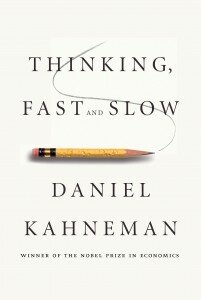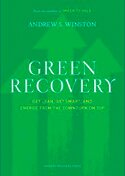Archive for the ‘Books’ Category
Loss aversion looms large in branding
Not long ago I believed sustainable business, renewable energy and the socially responsible consumer were on the verge of going mainstream. I know they will get there eventually, but that day now seems farther away.
Those of us impatient for change — in our organizations, among our customers, within society — would do well to sit with this fact: People are more motivated to avoid losses than to achieve gains. How much more? About twice as motivated.
This is just one of many thought-provoking research findings explained by preeminent psychologist Daniel Kahneman in his latest book, “Thinking, Fast and Slow.”
This is my second post exploring what some of Kahneman’s findings could hold for brands and the organizations and leaders managing them. Earlier I looked at the distinction between plausibility and probability in the brand stories we tell. Here I’m interested in what humans’ deep-seated aversion to loss means for purveyors of change. (more…)
Is your brand story merely plausible?
Some years ago I led the public relations launch of a next-generation “bet your company” software platform for my employer at the time. The product promised to transform an industry and ensure the business retained its star status. Those of us charged with the product marketing did a fabulous job of storytelling. We had the national trade media eating out of our palms, giving us positive, prominent coverage in one publication after another.
But there was one small problem: Our firm never delivered the product — at least not nearly as advertised.
We had sold an incredible story, not an incredible product.
Today, I am looking back at that experience through the lens of one of the most provocative books I have read in years: “Thinking , Fast and Slow” by Daniel Kahneman, winner of the 2002 Nobel Prize in Economic Sciences. Kahneman is actually a psychologist but his work around decision making challenged the prevailing rational model of judgment in economics. He is professor emeritus at Princeton University. (more…)
, Fast and Slow” by Daniel Kahneman, winner of the 2002 Nobel Prize in Economic Sciences. Kahneman is actually a psychologist but his work around decision making challenged the prevailing rational model of judgment in economics. He is professor emeritus at Princeton University. (more…)
Nonprofit branding: What, why and how
I’m often hesitant to mention “branding” — the core of my consulting work — in nonprofit circles. The reason is simple: It can be a conversation killer.
New research by Harvard’s Nathalie Kylander and Christopher Stone suggests why. Drawing on interviews across 41 organizations, Kylander and Stone identify four reasons for skepticism toward branding among nonprofits:
- Nonprofit leaders widely associate branding with “the commercial pursuit of monetary gain,” which debases their work.
- A brand is often seen as “peremptorily imposed from above” in lieu of a strategic planning process, which is viewed as more participatory.
- Some believe leadership vanity is a larger motivation for branding than fulfilling a mission.
- Large nonprofit “bully brands” overshadow weaker organizations and “give brand management a bad reputation.”
 These and other reasons for skepticism can’t change one fact: Any organization, nonprofit or for-profit, has a brand the moment it opens for business and people experience it. The question isn’t brand or no brand; it’s how well the brand is managed, communicated and experienced. (more…)
These and other reasons for skepticism can’t change one fact: Any organization, nonprofit or for-profit, has a brand the moment it opens for business and people experience it. The question isn’t brand or no brand; it’s how well the brand is managed, communicated and experienced. (more…)
So much content marketing, so little change
“Why Content Marketing Is King,” touted a story last week about a recent business survey. There’s no denying the need for quality content. But for many of us marketers, elevating content to royalty distracts us from the work that should matter most: creating behavioral change.
My consulting practice centers on progressive businesses and nonprofits that are trying to change the world, their organization or their stakeholders in ways large and small. We all know from experience that personal change can be hard. So it’s no surprise that trying to influence change in others can seem impossible or painstakingly slow. And if we’re not careful as marketers, throwing more content at the problem will only make matters worse.
The world is drowning in content generated by marketers — blog posts, case studies, white papers, ebooks, videos, photos — and the social media meant to publicize and disseminate the content. It’s axiomatic in marketing circles that awareness precedes action. Some content is aimed at creating initial awareness. Other content is produced to generate leads, establish thought leadership or deepen customer loyalty. Too often, however, the marketing objective becomes producing more content instead of the change we seek. (more…)
How to emerge green and ahead after recession
Making the business argument for going green can be tough even in the best of times. Trying to make it during the Great Recession? Forget about it.
Or so goes the conventional line of thinking.
Consultant Andrew Winston, author of the popular book “Green to Gold,” wants you to believe otherwise. He makes his case in his new book, “Green Recovery: Get Lean, Get Smart, and Emerge from the Downturn on Top.” Winston writes:
Winston writes:
This book presents an optimistic view of what green can do for your company in hard times.
Optimistic, yes. And realistic. Winston knows the recession has knocked businesses and their customers back on their heels. There are few companies today with the financial wherewithal or stomach for large-scale sustainability initiatives.
So what’s a company to do? Winston has plenty of suggestions. His small book reads like a how-to guide for businesses, with easy-to-digest lists of pragmatic reasons and low-cost methods for becoming more sustainable.
Focusing scarce resources
He offers four broad recommendations and organizes his book around them:
- Get lean: You can generate savings fast by reducing energy costs and consumption in your buildings and facilities, data centers, distribution operations, employee travel and by reducing and recycling waste.
- Get smart: Collect data on your environmental footprint, internally and across your value chain, and make it available to the people who can best use it to create change.
- Get creative: Creativity is free. And green innovation is what will set you apart as your competitors stand still. Ask “big, heretical questions.”
- Get (your people) engaged: Winston says, “In these times of low morale, and perhaps because of the stress of harder economic conditions, many people want more meaning at work. A green focus will both engage and inspire your people to keep going through tough times.”
Reducing your environmental footprint now can create advantage over your lesser-prepared competitors. Before long, however, you and your competitors will have no choice. Powerful forces remain at work even as the current  economy struggles and squeezes profits. Chief among them are climate change and constraints on natural resources and nonrenewable energy.
economy struggles and squeezes profits. Chief among them are climate change and constraints on natural resources and nonrenewable energy.
In his conclusion, Winston writes:
As hard as it may be to imagine, green pressures will force even larger, more sustained changes in business than current economic pressures. We’re talking about a fundamental shift in how the world works.
Application to smaller businesses
Most of Winston’s examples are from larger companies. I asked Winston in an email whether his recommendations work equally well for smaller businesses.
In short, yes, all of these strategies and tactics apply very well for smaller companies. In fact, smaller enterprises may feel more strain on cash flows and need to get lean even faster. The one caveat is whether any capital is available for investment in environmental improvements.
Winston recommends setting aside a portion of planned capital expenditures for environmental priorities, such as energy reduction. He also says smaller businesses may have the advantage when asking the heretical question. “Arguably smaller companies will be less tied to the status quo and more able to foment disruptive change,” he told me.
And what about Social Recovery?
I also asked Winston why he only briefly mentions the social dimension of sustainability.
Part of the answer is based in my expertise and focus. Another is that the ideas for getting lean as a way to fund a Green Recovery need to be focused on quick paybacks, and those types of initiatives tend to be more environmental: saving money on facilities, on IT, etc. It’s harder to pursue the social agenda as a cost-saving path…That said, many companies are building strong brands by hitting themes of transparency, responsibility and corporate citizenship.
Winston comes off as a pragmatist with deep concerns about the environment and the readiness of business to deal with what’s ahead. And for good reason. A new study of 1,500 corporate executives finds only 30 percent of companies have developed a clear business case for sustainability. Another recent study of major U.S. businesses concludes:
The current state of corporate environmental policy and management is surprising, perhaps even shocking.
Seizing the opportunity
Looking past the woeful business response to our environmental challenges lies a classic business opportunity. Iconic environmental businessman Paul Hawken, speaking in Portland, Ore. this month, asserted: “There’s no such thing as bad news about the environment, only information.” And in that information lies the makings of commercial success for those paying attention.
Winston sounds a similar theme.
Some companies that had a weak commitment to sustainability may be pulling back now. What a great opportunity to lead.
New discussion course for business sustainability
Sustainability is a huge topic. And many feel it lacks a clear definition. No wonder so many businesses that want to do the right thing don’t know how or where to start down the sustainability path.
Enter the nonprofit Northwest Earth Institute, based in Portland, Ore. NWEI has answered the call of businesses and other organizations looking for a way to start — or perhaps kick start — sustainability initiatives. NWEI’s response is a new discussion course designed specifically for the workplace, called “Sustainable Systems at Work.”
In the interest of full disclosure, I am on the NWEI board. As someone who’s participated in previous NWEI discussion courses, I can vouch for the power and inspiration in the model of peer group learning used by NWEI.
Each of NWEI’s courses takes a grass roots approach to sustainability, consistent with the Institute’s mission of “Inspiring people to take responsibility for Earth.” The previous seven courses offered by NWEI are designed to inform and inspire people in support of individual behavior change. The new workplace course is tailored to empower groups of employees at all levels to create or support sustainability projects or programs within their business. This bottoms-up approach creates employee champions for sustainability, as well as employee buy-in for environmental or social initiatives already in place.
Over a course of five sessions (60-90 minutes each, typically one session per week), employee groups will:
- evaluate the current economic model and consider the case for change
- examine the concept of sustainability from an organizational perspective
- evaluate principles and frameworks for guiding a vision
- identify tools and strategies for implementing a framework
- develop an action plan to advance organizational change
The course book, produced in cooperation with The Natural Step Network, contains articles and excerpts from experts and authors on business and workplace sustainability. The readings and companion discussion questions and exercises are designed to move employees quickly from learning and conversation into action. Mike Mercer, executive director of NWEI, says it’s all about engaging employees from the ground up.
Most organizations are launching sustainability initiatives from the top down, which they should. However, for culture and practices to change within an organization, employee commitment is a must. We believe innovation at its best occurs at all levels, and is driven by shifts in thinking. Our programs drive just that.
So if your business or some business you know is looking for a door into sustainability or the key to unlocking employee passion for sustainable change, get in touch with NWEI. They can help.

